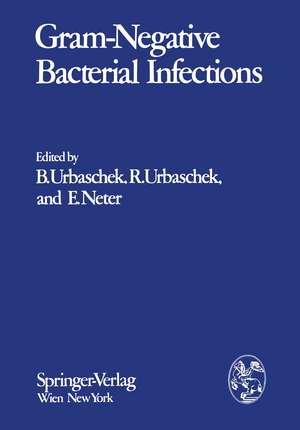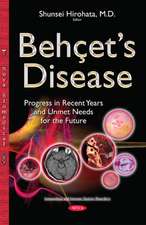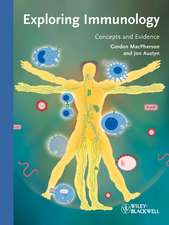Gram-Negative Bacterial Infections and Mode of Endotoxin Actions: Pathophysiological, Immunological, and Clinical Aspects
Editat de Bernhard Urbaschek, Renate Urbaschek, Erwin Neteren Limba Engleză Paperback – 9 ian 2012
Preț: 386.46 lei
Preț vechi: 406.80 lei
-5% Nou
Puncte Express: 580
Preț estimativ în valută:
73.96€ • 77.12$ • 61.47£
73.96€ • 77.12$ • 61.47£
Carte tipărită la comandă
Livrare economică 21 martie-04 aprilie
Preluare comenzi: 021 569.72.76
Specificații
ISBN-13: 9783709183984
ISBN-10: 3709183987
Pagini: 544
Ilustrații: XVI, 524 p.
Dimensiuni: 170 x 244 x 29 mm
Greutate: 0.86 kg
Ediția:Softcover reprint of the original 1st ed. 1975
Editura: SPRINGER VIENNA
Colecția Springer
Locul publicării:Vienna, Austria
ISBN-10: 3709183987
Pagini: 544
Ilustrații: XVI, 524 p.
Dimensiuni: 170 x 244 x 29 mm
Greutate: 0.86 kg
Ediția:Softcover reprint of the original 1st ed. 1975
Editura: SPRINGER VIENNA
Colecția Springer
Locul publicării:Vienna, Austria
Public țintă
ResearchCuprins
I. Microbiology and Epidemiology.- The Nature of Specific and Nonspecific Gram-Negative Infections Including Enteropathogenic E. coli Enteritis..- Gram-Negative Bacteria: The Determinants of Pathogenicity.- Studies on Shigellosis and Salmonellosis.- Extrachromosomal Characters as Determinants of Pathogenicity in Enterobacteriaceae.- Gram-Negative Rods as Agents of Nosocomial Disease: Some Recent Developments, with Comments on Mixed Cultures.- Anaerobic Bacteria and their Role in Human Infections.- Immunoresponse to Gram-Negative Bacteria in Infants: An Aspect of Pathogenesis of Urinary Tract Infections.- The Differentiation of the So-Called Coliform Bacteria in Medical Specimens.- Changes and Present Status of Resistance to Antimicrobial Drugs in Gram-Negative Bacteria.- Discussion.- II. Immunology.- Opposing Effects of Immunity to Endotoxin: Hypersensitivity Versus Protection.- Infections in Immunodeficiency States.- Species Differences in the Effectiveness of Intestinal Barriers against Penetration of Inert Particulates and Bacteria.- Transformation of Mouse B-Lymphocytes by the Lipid Component of Endotoxin.- Evaluation and Action of Biological Activity of Mediators Generated from Normal Serum by Interaction with Foreign Macromolecules.- Purification of PO, Antigenic Subfraction of the Endotoxin Extracted from S. typhi O 901.- Type Specific and Cross Reactive Antigens of Gram-Negative Bacilli in Protection against Infection.- Discussion.- III. Nonspecific Resistance and Endotoxin Tolerance.- Recent Developments Especially Significant for Ascertaining the Mechanisms of Endotoxin-Enhanced Nonspecific Resistance.- Mechanisms of Endotoxin Tolerance and their Effectiveness during the Febrile Phase of Gram-Negative Bacterial Infections in Man.- The Mitogenic Activity of Lipopolysaccharides on Lymphocytes in Culture I. Blastogenic Activity of Lipopolysaccharide in Mouse Lymphocytes Depleted of Antigen Reactive Cells.- The Role of Humoral and Cellular Factors in the Stimulation of Nonspecific Resistance Induced by Endotoxin.- Genetic Control of Immune Responsiveness of Mice to a Soluble Brucella abortus Antigen.- Discussion.- IV. Pathophysiology.- Nature and Specificity of Human Erythrocyte Membrane Receptor for Bacterial Endotoxins.- The Mitogenic Activity of Lipopolysaccharides on Lymphocytes in Culture II. Comparative Study in Five Mammalian Species.- Function of Leukocytes in Defense Mechanisms.- The Effect of Detoxified Endotoxin on Bone Marrow.- Changes of the Bone Marrow in Endotoxin Shock.- Endotoxin-Induced Tumor Resistance.- Discussion.- V. Hemodynamics and Metabolism.- Correlation between Circulatory Status and Energy Metabolism in Various Tissues during Endotoxin Shock.- Prognostic Indices for Assessment of Patients with Gram-Negative Bacteremia and Shock. An Evaluation of Hemodynamic, Respiratory and Metabolic Parameters.- Abnormalities of Energy Metabolism in Sepsis and Endotoxemia.- Changes in Hemodynamics and Gas Metabolism after Endotoxin Injection.- Mesenteric Hemodynamics in Endotoxin Shock.- Effect of Endotoxin on Metabolism and the Metabolic Changes in Bacterial Shock.- Assessment of Studies in the Biochemistry and Immunology of Endotoxemia.- Carbohydrate Metabolism during Experimental Endotoxemia.- Mitochondrial Metabolic Alterations in Experimental Circulatory Shock.- Serum Lipids in Experimental Consumption Coagulopathy Induced by Endotoxin and Thorotrast.- Changes of Lipoproteinlipase (LPL) after Intravenous Injection of Endotoxin.- Discussion.- VI. Pharmacology.- Pharmacological Aspects of Endotoxin Effects.- Initial Liberation of Biogenic Amines and Effect of Further Mediators Following Application of Endotoxins.- Some Aspects of the Effects of Endotoxin, Endotoxoid, and Biogenic Amines.- Biological Consequences of Endotoxin Interaction with Complement.- Influence of Lipid A and Various LPS-Preparations on the Third Component of Complement (C3): Biological Significance of this Interaction.- Some Aspects ofthe Effects of Endotoxin on the Central Nervous System.- Discussion.- VII. Blood Coagulation.- Consumption Coagulopathy in the Course of Endotoxinemia.- The Activation of Intravascular Coagulation by Endotoxin.- Trigger Mechanism of Endotoxin-Induced Intravascular Coagulation.- Blood Coagulation Mechanism and Endotoxins: Hemostatic Defect in Septic Shock.- High Molecular Weight Derivatives of Fibrinogen and their Relation to the Total Fibrinogen Content Following the Infusion of Endotoxin in Pregnant Rabbits.- Endotoxin Effects on Kidney Morphology and Function.- Pathomorphology of Intravascular Coagulation Following Endotoxin Administration.- Discussion.- VIII. Clinical Aspects Including Shock.- Clinical Features in Shock Associated with Gram-Negative Bacteremia.- The Pulmonary Response to Sepsis and Endotoxin: Clinical and Experimental Observations.- On the Escape of Endotoxin from the Intestine.- Pyelonephritis: Pathogenesis and Unsolved Problems.- Endotoxin Shock in Obstetrics.- Clinical Use of Endotoxoid.- Discussion.- IX. Burn Disease.- Bacterial Infection in Burn Disease.- Bacteremia in the Course of Burns with Special Regard to the Initial Release of Mediators by Burn Trauma.- Pathogenetic and Immunotherapeutic Significance of a Specific Cutaneous Human Burn Toxin.- Immunization against Pseudomonas in Burn Disease.- Active Immunization against Pseudomonas aeruginosa in Burns.- Discussion.









